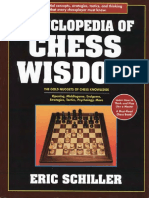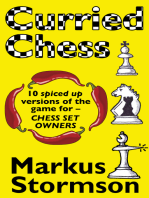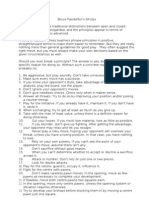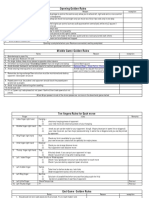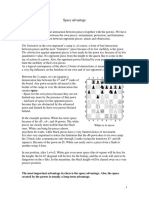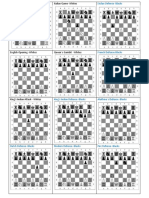End Games
End Games
Uploaded by
zainhumayun95Copyright:
Available Formats
End Games
End Games
Uploaded by
zainhumayun95Copyright
Available Formats
Share this document
Did you find this document useful?
Is this content inappropriate?
Copyright:
Available Formats
End Games
End Games
Uploaded by
zainhumayun95Copyright:
Available Formats
General Notes: Always have a strategy or game plan. Dont move until you see it!
Dont be afraid to make long calculations. Utilise the last remaining shred of energy to achieve the result and not throw it away. Make the correct exchanges. Exchanging B for A can be very important if it weakens the opponents pawn structure, creates a passed pawn and improves your position. Immobilising one of the opponents pieces can be equivalent to being a piece up in the endgame. Always a good idea. Pawn islands. Making holes in the opponents pawn structures is important so that the pawns cannot advance, putting up walls and stopping the king from playing an active role. Plus, they become easier to pick off. In the endgame, identify good positions and outposts for your pieces, and then occupy them. Bishops: Try to maximise the potential of your bishops by choosing a diagonal where they are most effective. They can be extremely powerful along a single diagonal, protecting your own pawn and preventing the opponents from advancing. Remember! It is not always possible to convert the endgame into a win without compromising material advantage. Sometimes, a sacrifice can be necessary for a win. King and Pawn Endgames: Up to the 5th rank, the attacking king should be two ranks ahead of the pawn. When the pawn reaches the 5th rank, the king only needs to be one rank ahead. Whenever the defending king leaves a critical square, the attacking king should advance. To force the defending king to leave the defence of a critical square, the attacking king should maintain its opposition. Likewise, the defending king should maintain opposition to achieve a draw. It all depends on whose turn it is. Note: When the last pawn is on the rook files, all the defending king has to do is occupy the corner, and the game will be drawn Queen and King against King and Pawn: Usually an easy win, but a draw if the pawn is on the 7th rank, in the rook or bishop files. With the queen, try to occupy the queening square, and bring your king in slowly. The technique is to keep on checking him or pinning him, force the king in front of the pawn and then bring your king one step closer. Kings and Pawns: 1) Mutual Zugzwang when each king is blocking an opposing pawn and the two pawns are side by side. If either king moves, a pawn will be lost.
2) When pawns are on d2 and e3 for example, with a king on d3, then the two pawns defend themselves. The pawn on e3 cannot be taken, and if the pawn on d2 is taken, the king never get back in time to stop the advancing pawn on e3 from promotion. 3) If two pawns are on the same rank, a file apart, they also defend themselves. The squares in the middle are under attack, so the king cannot occupy the middle ground. If the king attacks the pawn on the left, the pawn on the right can be pushed, and vice versa. If the king does not attack, the pawns can be advanced by wasting a move and maintaining the same pawn structure. 4) Pawns two files apart do not defend themselves, unless for example they are both about to queen. 5) Will the king stop the advancing pawn? If the king can occupy the imaginary square formed by the advancing pawn, no matter whos move it is, then yes, the king can stop it. Bishops of the same colour: Triangulation. Bishops can be used to lose a move and force zugzwang on the opponent. Powerful when the opponent is slowly choked, eventually forced to run out of moves. For this to work, a strong central king, and better pawns, are required. An active king is crucial. In the endgame, the king should always be used as a main weapon. Try to paralyse the opponents king. When there are two bishops of the same colour, your bishop can be used to protect a pawn as it tries to advance up the rook file. Just use your bishop to protect the few squares on the rook file that it can, and the other bishop cannot stop the pawn. If a knight is separated from a bishop by two or more ranks or files, the bishop can occupy a central position, completely stopping the knight from progressing in that direction. Bishop against Knight A bishop can cover both sides of the board very quickly by being able to travel large distances quickly. The knight, however, can cover both light and dark squares, unlike a single bishop. Note: with Bishops, your no.1 priority should be to lock your opponents pawns on the correct squares, and mobilise your own pawns. The first move of the endgame should be a sound structural one Note: in an endgame with king and bishop against king and pawn, if the bishop cannot attack the corner, then the game is a draw because all the defending king has to do is occupy the corner and stalemate will ensue. If, though, the bishop can attack the corner, then the defending king will eventally be forced to move away and the attacking king can marshal its pawn to promotion. Knight against Bishop Completely immobilise the opponents bishop. Manipulate pawn structures to develop a closed game to favour your knight and further immobilise the bishop. Try to create an outpost for the knight so that the king can come into play.
Knight & Bishop against Rook Dominate the board with the two pieces to render the rook useless. As the pawns are prepared to be pushed up the board, defend the squares ahead which the bishop cannot, with the knight. Using the pawns, king, and the knight and bishop in tandem, a wall can be set up to advance the pawns and defend against the bishop. The pawns, remember, should be on the opposite coloured squares of the bishop to not hinder its movement.
Bishops of opposite colour Tend to be drawish, because sometimes material advantage is not enough to force a win. The principle of two weaknesses is very important, as it is in the middlegame as well. Try to keep his king busy by distracting him with a potential passed pawn on one side, and his bishop on the other. The bishop should then be attacked while ensuring that the king is too far away to help. Remember, the initial outpost for the king is very important. Since it can be placed on a square opposite to the colour of the opponents bishop, it can never be dislodged. And vice versa. Deny the opponent the opponent to create an outpost for his king. Try to create as many problems for your opponent as possible. But most importantly, if you have sufficient material, try to avoid such endgames, because they are very drawish. Understatements. Try to provoke your opponent to weaken his own position. Rook and Pawn Endgames 2 rules: The Rook must be behind the passed pawn. Second, the passed pawn must be pushed.
i / 10-2 32 2016 4442084
You might also like
- Encyclopedia of Chess Wisdom - Schiller 2003, 434pDocument434 pagesEncyclopedia of Chess Wisdom - Schiller 2003, 434pEmilio Murillo100% (9)
- ChessKid Curriculum v2019Document550 pagesChessKid Curriculum v2019Jefferson Johan / XII MIPA 6 / 19No ratings yet
- Dungeon Magazine - 118-121 Greyhawk Map - GRz9ZbDocument6 pagesDungeon Magazine - 118-121 Greyhawk Map - GRz9Zbwisomi4762100% (1)
- G.M.Ram Essential Grand Master Chess (Español)Document103 pagesG.M.Ram Essential Grand Master Chess (Español)robert100% (6)
- Sahovsky - Enciclopaedia Del Medio Juego Problemasinformator PDFDocument391 pagesSahovsky - Enciclopaedia Del Medio Juego Problemasinformator PDFJorge Koky Nureña PlasenciaNo ratings yet
- Game Manual 2.0: All That We See or Seem Is But A Dream Within A Dream. - Edgar Allan PoeDocument20 pagesGame Manual 2.0: All That We See or Seem Is But A Dream Within A Dream. - Edgar Allan PoeNicola PaolettiNo ratings yet
- Middle Game PlansDocument19 pagesMiddle Game PlansVon Greggy Moloboco IINo ratings yet
- Alekhines Defence - Eales & WilliamsDocument138 pagesAlekhines Defence - Eales & WilliamsAnderson J F de OliveiraNo ratings yet
- English OpeningDocument6 pagesEnglish OpeningbanetrazeNo ratings yet
- Chess MaximsDocument2 pagesChess MaximssanflashNo ratings yet
- PDF File - Must-Know Endgame TheoryDocument43 pagesPDF File - Must-Know Endgame TheoryAnna KhachatryanNo ratings yet
- The Basics of Chess PrinciplesDocument11 pagesThe Basics of Chess PrinciplesSrdjanNo ratings yet
- Good Chess Guidelines For Beginning Amateur PlayersDocument5 pagesGood Chess Guidelines For Beginning Amateur Playersnreload100% (1)
- Chess Instruction For BeginnersDocument7 pagesChess Instruction For Beginnersvaasto20030% (1)
- Chess VocabularyDocument9 pagesChess VocabularyMatthew KolczNo ratings yet
- Importance of EndgameDocument6 pagesImportance of Endgamesatthak guptaNo ratings yet
- Scholastic Chess Made Easy: A Scholastic Guide for Students, Coaches and ParentsFrom EverandScholastic Chess Made Easy: A Scholastic Guide for Students, Coaches and ParentsNo ratings yet
- Tal System: A System of Accurate AttackDocument3 pagesTal System: A System of Accurate AttackEddie Resurreccion Jr.No ratings yet
- Tactics, Lesson 1 - The EssenceDocument8 pagesTactics, Lesson 1 - The EssenceAnderson PinheiroNo ratings yet
- Chess Lesson 2Document4 pagesChess Lesson 2Elendu Emmanuel ChigozieNo ratings yet
- Pawn Center TypesDocument6 pagesPawn Center TypesRimuel92No ratings yet
- Dokument - Pub RBR Gurukul Ep 26 Flipbook PDFDocument14 pagesDokument - Pub RBR Gurukul Ep 26 Flipbook PDFArjun PaliwalNo ratings yet
- ExcellentDocument4 pagesExcellentChandaKundaNo ratings yet
- Novice Nook: Analysis TipsDocument6 pagesNovice Nook: Analysis TipsZAAAjgt86bhgvcfNo ratings yet
- Heisman 39Document8 pagesHeisman 39initiative1972No ratings yet
- Chess LessonDocument65 pagesChess LessonManueli Kebbles MckubwaNo ratings yet
- My Chess BookDocument20 pagesMy Chess BookSamad Morayur100% (1)
- How To Formulate A Plan in Chess - JEREMY SILMANDocument3 pagesHow To Formulate A Plan in Chess - JEREMY SILMANJames de Assis SilvaNo ratings yet
- Chess Board Geometry - OneDocument3 pagesChess Board Geometry - OneVerkey DanNo ratings yet
- 64 Chess TipsDocument3 pages64 Chess TipsmisterqwertyNo ratings yet
- Basic Elements in Playing ChessDocument50 pagesBasic Elements in Playing Chessjohn_tuinman_1No ratings yet
- Basic Chess Rules - Markushin PDFDocument9 pagesBasic Chess Rules - Markushin PDFgajakarnikaNo ratings yet
- Chess For ZebrasDocument6 pagesChess For Zebrasradovanb0% (2)
- Ocena PozicijeDocument65 pagesOcena PozicijemilosNo ratings yet
- ChessVision - Checkmate - SAMPLEDocument18 pagesChessVision - Checkmate - SAMPLEAlchemos Zuckerberg100% (1)
- Chess ClassDocument4 pagesChess ClassNivedita Nandan0% (1)
- Lesson 17 PDFDocument11 pagesLesson 17 PDFJeise de MedeirosNo ratings yet
- Teaching Chess ChecklistDocument13 pagesTeaching Chess ChecklistikmcjuixNo ratings yet
- Uwe Boensch - Methods of Tactical TrainingDocument5 pagesUwe Boensch - Methods of Tactical Trainingpavel_janda_3100% (1)
- Chess Board: Points To RememberDocument7 pagesChess Board: Points To RememberRenukha PannalaNo ratings yet
- Golden RulesDocument2 pagesGolden RulesDibyendu KonarNo ratings yet
- Pawn Structure - StudyDocument5 pagesPawn Structure - Studychezzter25No ratings yet
- Complete Chess CourseDocument1 pageComplete Chess Coursemeyer2396No ratings yet
- Opposition, Technique & Advanced King Play: Lesson 15Document13 pagesOpposition, Technique & Advanced King Play: Lesson 15Jeise de Medeiros100% (1)
- New Chess CatalogDocument27 pagesNew Chess CatalogPriya AgrawalNo ratings yet
- Spotting Knight Forks in ChessDocument3 pagesSpotting Knight Forks in Chesspushkar100% (1)
- Ipatov Teaser Vol 1Document20 pagesIpatov Teaser Vol 1john100% (1)
- Xabcdefghy 8-Trlwq-Trk+ (7+P+Nzppvlp' 6P+-Zp-Snp+& 5+-Zpp+-+-% 4P+P+Pzp-Vl$ 3+-Sn-+N+P# 2-Zplwq-+P+" 1+-+-Trrmk-! XabcdefghyDocument6 pagesXabcdefghy 8-Trlwq-Trk+ (7+P+Nzppvlp' 6P+-Zp-Snp+& 5+-Zpp+-+-% 4P+P+Pzp-Vl$ 3+-Sn-+N+P# 2-Zplwq-+P+" 1+-+-Trrmk-! XabcdefghyMathi MuthuNo ratings yet
- Dokument - Pub RBR Gurukul Ep 26 Flipbook PDFDocument11 pagesDokument - Pub RBR Gurukul Ep 26 Flipbook PDFArjun PaliwalNo ratings yet
- Pattern Recognition SUMMARYDocument6 pagesPattern Recognition SUMMARYiulinutNo ratings yet
- Slav DefenceDocument3 pagesSlav DefenceMuhammad FarhanNo ratings yet
- Scandinavian DefenceDocument4 pagesScandinavian DefenceGCY56100% (1)
- Ten Useful Tips For ChessDocument14 pagesTen Useful Tips For ChesskalyanNo ratings yet
- Sam Shankland Grunfeld Chess SummaryDocument9 pagesSam Shankland Grunfeld Chess SummaryWilliam KerseyNo ratings yet
- The Secrets To Real ChessDocument4 pagesThe Secrets To Real ChessBassel SafwatNo ratings yet
- 9115 VhessDocument25 pages9115 VhessMathieu Coteur100% (1)
- Lesson 20 PDFDocument7 pagesLesson 20 PDFsubashNo ratings yet
- Learn How To Play Chess: The RulesDocument8 pagesLearn How To Play Chess: The RulesMani SainiNo ratings yet
- Learning ChessDocument2 pagesLearning ChessObedM0X100% (1)
- Chess Calculation Training For Kids and Club Players: Level 1: CheckmatingDocument12 pagesChess Calculation Training For Kids and Club Players: Level 1: CheckmatingMahesh Varyani100% (1)
- Extracted Pages From How Chess Games Are Won and Lost-HansenDocument5 pagesExtracted Pages From How Chess Games Are Won and Lost-HansenNicolas Riquelme100% (1)
- Franklin K. Young - The Major Tactics of Chess (1919) PDFDocument284 pagesFranklin K. Young - The Major Tactics of Chess (1919) PDFPetronio66100% (2)
- Top 10 Most Powerful Openings in Chess PDFDocument12 pagesTop 10 Most Powerful Openings in Chess PDFsyaf file gwNo ratings yet
- Interference (Chess)Document2 pagesInterference (Chess)lyna_mada_yahooNo ratings yet
- Arthur Van de Oudeweetering - Train Your Chess Pattern RecognitionDocument309 pagesArthur Van de Oudeweetering - Train Your Chess Pattern RecognitionGabriel Sala100% (5)
- 35) Chess - Evolution-2-Yusupov PDFDocument12 pages35) Chess - Evolution-2-Yusupov PDFhoni230% (3)
- Konotop - Chess Tactics Tests For The Highly Qualified Players (Solutions) - PUZZLES To SOLVEDocument12 pagesKonotop - Chess Tactics Tests For The Highly Qualified Players (Solutions) - PUZZLES To SOLVECarlos Alejandro Chavez100% (2)
- K. Muller & A. Markgraf - The Chess Puzzle Book 4Document187 pagesK. Muller & A. Markgraf - The Chess Puzzle Book 4Ezequiel Matías100% (1)
- TRG Yearbook 2011 - Booklet LDocument108 pagesTRG Yearbook 2011 - Booklet LAlanNo ratings yet
- Levon Aronian Best GamesDocument527 pagesLevon Aronian Best GamesNewko BalkanNo ratings yet
- GAMES SPORTS MECHANICS IntramuralsDocument7 pagesGAMES SPORTS MECHANICS IntramuralsEllaine Rebecca LimosineroNo ratings yet
- 2016 May Chronicle AICFDocument52 pages2016 May Chronicle AICFSundaramurthyNo ratings yet
- List of Selected FormulaeDocument3 pagesList of Selected FormulaePui San LimNo ratings yet
- Jadual Penuh Hoki SBP 2023Document9 pagesJadual Penuh Hoki SBP 2023wrdhwatfNo ratings yet
- chatGPT Prompt - MIDI2textDocument10 pageschatGPT Prompt - MIDI2textArthurNo ratings yet
- Summary The King HuntDocument6 pagesSummary The King Huntansuman supermanNo ratings yet
- Other or Uncategorized Chess Problems: Jaroslav Stun SlovakiaDocument8 pagesOther or Uncategorized Chess Problems: Jaroslav Stun Slovakiabehzad parsiNo ratings yet
- Common Sense in Chess New 21st Century Ed 9781888690408 1888690402 CompressDocument129 pagesCommon Sense in Chess New 21st Century Ed 9781888690408 1888690402 CompressFgetulioNo ratings yet
- Chess Results ListDocument4 pagesChess Results ListDasharath NagvekarNo ratings yet
- Nimzowitsch Vs Salwe 1911Document2 pagesNimzowitsch Vs Salwe 1911Manuel Arellano MartinezNo ratings yet
- Ruy Lopez Exchange-BookDocument195 pagesRuy Lopez Exchange-BookChandaKundaNo ratings yet
- Basic Xiangqi CheckmatesDocument222 pagesBasic Xiangqi Checkmatesramez1863No ratings yet
- Outrageous Chess ProblemsDocument4 pagesOutrageous Chess ProblemsoqwifbhNo ratings yet
- Chess Tactics For Beginners 3Document132 pagesChess Tactics For Beginners 3cgycgy100% (2)
- My Joyous Battles With Chess Villains - David LuckyDocument353 pagesMy Joyous Battles With Chess Villains - David LuckyDamirDesevacNo ratings yet
- Dvoretsky Trap 1 PDFDocument10 pagesDvoretsky Trap 1 PDFUjaan BhattacharyaNo ratings yet
- 06 Colle6Document10 pages06 Colle6Frank RyanNo ratings yet
